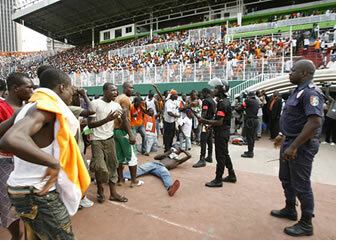The Soccer World Cup is the most important tournament in this sport, being held every four years. In the 2010 edition, a country on the African continent will host the competition for the first time – South Africa.
As the name says (World Cup), this event involves teams from several continents. There are 32 soccer teams in search of the world champion title. The countries classified for the competition are:
Africa: South Africa, Algeria, Cameroon, Côte d'Ivoire, Ghana and Nigeria.
America:
North America: United States and Mexico.
Central America: Honduras.
South America: Argentina, Brazil, Chile, Paraguay and Uruguay.
Asia: North Korea, South Korea and Japan.
Europe: Germany, Denmark, Slovakia, Slovenia, Spain, France, Greece, Holland, England, Italy, Portugal, Serbia and Switzerland.
Oceania: Australia and New Zealand.
Europe is the continent with the highest number of representatives (13), in addition to having the most favorites to win the competition (Germany, Spain, France, Netherlands, England and Italy). However, technical differences between teams are very small compared to differences in socioeconomic patterns between countries.

Australia fans
The Human Development Index (HDI) is an indicator of the quality of life of the population in a given location and the discrepancy between the averages among the countries participating in the World Cup is alarming. Australia, for example, has an HDI of 0.937; Côte d'Ivoire, in turn, has an average of 0.397.
Do not stop now... There's more after the advertising ;)
Most European countries participating in the competition do not have illiterate inhabitants. Approximately 52% of the population of Côte d'Ivoire is affected by illiteracy. In Brazil, this average is 10%.
The infant mortality rate in Japan is only 3 deaths per thousand live births; in Paraguay, there are 31 deaths for every thousand live births and in Cameroon this rate is extremely high: 85.

Ivory Coast fans
The fact is that on the field, where 11 athletes represent each team, these socioeconomic differences do not interfere in the results of the matches, as an African team always stands out, and countries with high social standards do not have representation in the football world, such as Australia, which holds the best HDI among countries participating in the World Cup in Soccer. However, these social and economic disparities reflect on the quality of life of these inhabitants, being necessary a better distribution of wealth so that better living conditions are provided for the whole humanity.
Already Brazil, a country in the process of development, being considered an emerging nation, is the biggest winner of the tournament (five times). We hope that the national team can be champions again and that it continues to show improvements in its socioeconomic indicators.
By Wagner de Cerqueira and Francisco
Graduated in Geography
Brazil School Team
South African Trivia - South Africa - Brazil School
Would you like to reference this text in a school or academic work? Look:
FRANCISCO, Wagner de Cerqueira e. "The Inequality Cup"; Brazil School. Available in: https://brasilescola.uol.com.br/africa-do-sul/a-copa-desigualdade.htm. Accessed on June 29, 2021.

